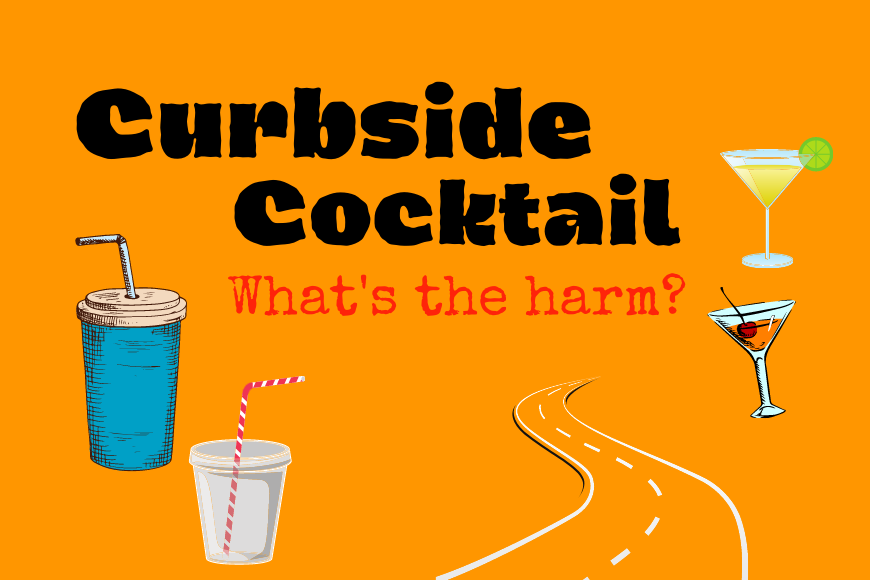
In the last four months, we have all witnessed the drastic changes in our towns and cities across the state due to the worldwide pandemic from the COVID-19 outbreak. One of the first and noticeable differences in our communities was the shift from dining out at the local restaurants, to curbside pick-up only. Along with this new approach to food pick-up was the shift in access to alcohol with curbside cocktail pick-up. In an effort to keep the economy as healthy as possible the state of Vermont has allowed restaurants to sell alcohol in take-out form, yet arguably the sacrifice of public health was put at more risk. We recently interviewed our local Department of Liquor Control representative, Melanie Gaiotti who was able to give us a more in-depth description of the impact that this new way of serving alcohol is affecting our health, our safety, our youth, and our communities.
To fully understand the process of curbside cocktail pick up, we asked Melanie Gaiotti to explain the current procedure of ordering a cocktail at a local restaurant, checking ID’s, and picking up an order. If you have ordered from a restaurant recently you might know that alcohol orders are supposed to be part of a food order, meaning a customer should not be ordering just cocktails. Currently, there are no limitations to how many cocktails a person can order with their food, and since the pandemic, the amount of alcohol varies from restaurant to restaurant, as well as from cocktail to cocktail (though it should be noted that 4 ounces of liquor is the limit on how much alcohol can be put into a standard mixed drink for on-premise consumption, however, during to-go times that amount has been altered). What this information means, is that if I am 21 or older, I can place an order for a burger, fries, and 25 margaritas (depending on the discretion of the establishment of course). Similar to the inconsistency of cocktail serving size is the inconsistency in the container for which the cocktails are served for pickup. As Melanie Gaiottii describes, it is not uncommon for restaurants to serve curbside cocktails in to-go cups with straws that are taped down to a plastic lid. While we can assume that the straw being taped to the lid is intended to be a reminder for the customer to avoid drinking the cocktail until it is safe and legal, we can also assume that the ease of accessing the alcohol from a to-go cup with a straw may increase the likelihood of illegal behaviors, such as drinking and driving.
As it relates to the law, Melanie Gaiottii has also witnessed some deficiencies in the process of checking for valid identification for the legal sale of curbside cocktail pickup. While she did state that many restaurants were checking for ID, the way that ID checks were happening was different from restaurant to restaurant and not always thorough. One of the more obvious flaws in ID checks that she mentioned was the use of window ID checks; while restaurants are adhering to the social distancing recommendations, in some cases, staff was not physically handling the customers' ID which was concerning. As you may not be aware, to the naked eye a fake ID can look very real, it is not until the ID is handled that a staff member might be alerted to potential fraud due to the flimsy, thin, or even lightweight material that is often used to create a fake ID. This oversight is concerning as it relates to increased youth access to alcohol during the distraction of the pandemic.
In April, alcohol sales were up 14% in Vermont, and the most cases of a specific kind of alcohol being sold in Vermont this spring was a brand of cinnamon whisky called Fireball. If you are not familiar with this brand of whisky, it's most popular among a younger audience of drinkers (high school and college-aged students); this is not a sipping kind of whisky nor is it marketed to be. The story behind the sales of Fireball has yet to be told with local data, but based on what we do know about the product, we can predict that alcohol consumption increased among the younger population in our communities during that time, and any long-term effects have yet to be seen.
As we look ahead to the impact of increased alcohol consumption in Vermont, the inconsistencies of curbside cocktail pickup and deficiencies in the procedure of ID checks, our concerns as prevention experts are clear; decreased perception of harm, youth access to alcohol, increased youth alcohol consumption, increased social norms, decreased supervision relating to curbside cocktail pickup, inconsistency in ID checks, and increased drinking and driving due to alcohol being sold in to-go cups. United Way of Addison County is committed to the overall health, education, and financial stability, for all, we encourage you to help us be a part of keeping Addison County safe and healthy by talking with the youth in your life about substance prevention. Did you know, simply talking with youth about the risks of drinking alcohol can be enough to reduce their likelihood of underage alcohol consumption? For more information about how to talk with the youth in your life about substance use, visit www.parentupvt.org or contact one of our prevention experts at United Way of Addison County.
Jesse Brooks, Director of Prevention
United Way of Addison County